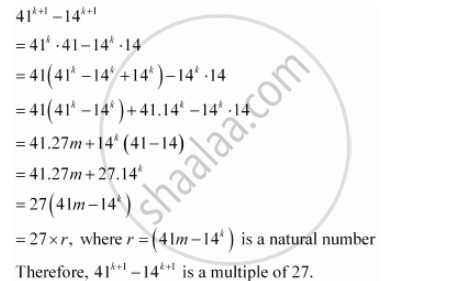Advertisements
Advertisements
Question
Prove the following by using the principle of mathematical induction for all n ∈ N: 41n – 14n is a multiple of 27.
Solution
Let the given statement be P(n), i.e.,
P(n):41n – 14nis a multiple of 27.
It can be observed that P(n) is true for n = 1 since `41^1 - 14^1 = 27`, which is a multiple of 27.
Let P(k) be true for some positive integer k, i.e.,
41k – 14kis a multiple of 27
∴41k – 14k = 27m, where m ∈ N … (1)
We shall now prove that P(k + 1) is true whenever P(k) is true.
Consider

Thus, P(k + 1) is true whenever P(k) is true.
Hence, by the principle of mathematical induction, statement P(n) is true for all natural numbers i.e., n.
APPEARS IN
RELATED QUESTIONS
Prove the following by using the principle of mathematical induction for all n ∈ N:
Prove the following by using the principle of mathematical induction for all n ∈ N:
Prove the following by using the principle of mathematical induction for all n ∈ N: `1+2+ 3+...+n<1/8(2n +1)^2`
Prove the following by using the principle of mathematical induction for all n ∈ N: n (n + 1) (n + 5) is a multiple of 3.
Prove the following by using the principle of mathematical induction for all n ∈ N: 102n – 1 + 1 is divisible by 11
If P (n) is the statement "n(n + 1) is even", then what is P(3)?
Give an example of a statement P(n) which is true for all n ≥ 4 but P(1), P(2) and P(3) are not true. Justify your answer.
\[\frac{1}{3 . 5} + \frac{1}{5 . 7} + \frac{1}{7 . 9} + . . . + \frac{1}{(2n + 1)(2n + 3)} = \frac{n}{3(2n + 3)}\]
2 + 5 + 8 + 11 + ... + (3n − 1) = \[\frac{1}{2}n(3n + 1)\]
1.3 + 2.4 + 3.5 + ... + n. (n + 2) = \[\frac{1}{6}n(n + 1)(2n + 7)\]
1.2 + 2.3 + 3.4 + ... + n (n + 1) = \[\frac{n(n + 1)(n + 2)}{3}\]
11n+2 + 122n+1 is divisible by 133 for all n ∈ N.
Prove that 1 + 2 + 22 + ... + 2n = 2n+1 - 1 for all n \[\in\] N .
x2n−1 + y2n−1 is divisible by x + y for all n ∈ N.
\[\text{ A sequence } x_0 , x_1 , x_2 , x_3 , . . . \text{ is defined by letting } x_0 = 5 and x_k = 4 + x_{k - 1}\text{ for all natural number k . } \]
\[\text{ Show that } x_n = 5 + 4n \text{ for all n } \in N \text{ using mathematical induction .} \]
\[\text{ The distributive law from algebra states that for all real numbers} c, a_1 \text{ and } a_2 , \text{ we have } c\left( a_1 + a_2 \right) = c a_1 + c a_2 . \]
\[\text{ Use this law and mathematical induction to prove that, for all natural numbers, } n \geq 2, if c, a_1 , a_2 , . . . , a_n \text{ are any real numbers, then } \]
\[c\left( a_1 + a_2 + . . . + a_n \right) = c a_1 + c a_2 + . . . + c a_n\]
Prove by method of induction, for all n ∈ N:
12 + 22 + 32 + .... + n2 = `("n"("n" + 1)(2"n" + 1))/6`
Prove by method of induction, for all n ∈ N:
Given that tn+1 = 5tn + 4, t1 = 4, prove that tn = 5n − 1
Answer the following:
Prove by method of induction 52n − 22n is divisible by 3, for all n ∈ N
Prove statement by using the Principle of Mathematical Induction for all n ∈ N, that:
22n – 1 is divisible by 3.
The distributive law from algebra says that for all real numbers c, a1 and a2, we have c(a1 + a2) = ca1 + ca2.
Use this law and mathematical induction to prove that, for all natural numbers, n ≥ 2, if c, a1, a2, ..., an are any real numbers, then c(a1 + a2 + ... + an) = ca1 + ca2 + ... + can.
Let P(n): “2n < (1 × 2 × 3 × ... × n)”. Then the smallest positive integer for which P(n) is true is ______.
A student was asked to prove a statement P(n) by induction. He proved that P(k + 1) is true whenever P(k) is true for all k > 5 ∈ N and also that P(5) is true. On the basis of this he could conclude that P(n) is true ______.
Prove the statement by using the Principle of Mathematical Induction:
23n – 1 is divisible by 7, for all natural numbers n.
Prove the statement by using the Principle of Mathematical Induction:
`sqrt(n) < 1/sqrt(1) + 1/sqrt(2) + ... + 1/sqrt(n)`, for all natural numbers n ≥ 2.
Prove that, sinθ + sin2θ + sin3θ + ... + sinnθ = `((sin ntheta)/2 sin ((n + 1))/2 theta)/(sin theta/2)`, for all n ∈ N.
Show that `n^5/5 + n^3/3 + (7n)/15` is a natural number for all n ∈ N.
Consider the statement: “P(n) : n2 – n + 41 is prime." Then which one of the following is true?
By using principle of mathematical induction for every natural number, (ab)n = ______.
